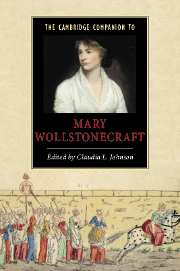Book contents
- Frontmatter
- 1 Introduction
- 2 Mary Wollstonecraft's letters
- 3 Mary Wollstonecraft on education
- 4 Mary Wollstonecraft's Vindications and their political tradition
- 5 Mary Wollstonecraft's French Revolution
- 6 Mary Wollstonecraft's literary reviews
- 7 The religious foundations of Mary Wollstonecraft's feminism
- 8 Mary Wollstonecraft and the literature of advice and instruction
- 9 Mary Wollstonecraft's A Vindication of the Rights of Woman and the women writers of her day
- 10 Mary Wollstonecraft and the poets
- 11 Mary Wollstonecraft's novels
- 12 Letters Written During a Short Residence in Sweden, Norway, and Denmark: traveling with Mary Wollstonecraft
- 13 Mary Wollstonecraft and the sexuality of genius
- 14 Mary Wollstonecraft's reception and legacies
- Select bibliography
- Index
12 - Letters Written During a Short Residence in Sweden, Norway, and Denmark: traveling with Mary Wollstonecraft
Published online by Cambridge University Press: 28 May 2006
- Frontmatter
- 1 Introduction
- 2 Mary Wollstonecraft's letters
- 3 Mary Wollstonecraft on education
- 4 Mary Wollstonecraft's Vindications and their political tradition
- 5 Mary Wollstonecraft's French Revolution
- 6 Mary Wollstonecraft's literary reviews
- 7 The religious foundations of Mary Wollstonecraft's feminism
- 8 Mary Wollstonecraft and the literature of advice and instruction
- 9 Mary Wollstonecraft's A Vindication of the Rights of Woman and the women writers of her day
- 10 Mary Wollstonecraft and the poets
- 11 Mary Wollstonecraft's novels
- 12 Letters Written During a Short Residence in Sweden, Norway, and Denmark: traveling with Mary Wollstonecraft
- 13 Mary Wollstonecraft and the sexuality of genius
- 14 Mary Wollstonecraft's reception and legacies
- Select bibliography
- Index
Summary
I perceive, but too forcibly, that happiness, literally speaking, dwells not here. And that we wander to and fro in a vale of darkness as well as tears.
(VRM 5:76)From the title of the last book published before her death, Letters Written During a Short Residence in Sweden, Norway and Denmark (1796), we can guess that for Mary Wollstonecraft the word “residence” reflects little stability or rest. A short residence in three countries? Over the course of one summer? Upheaval writes itself into the title, and becomes the motor of this peculiar but lovely book. HereWollstonecraft takes the restlessness and dislocation that marked her own life, as well as the society she observed in northern Europe, and tries to shape them into a style, an argument, and a political stance. “The art of travelling,” she remarks elsewhere, “is only a branch of the art of thinking.” In the Short Residence the thinking subject herself cannot be distinguished from constant movement. Her travelogue thus tells us more about the mind of the traveler-subject, charting her path through a “heterogeneous modernity,” than about the three countries she visits. During her Short Residence, the narrator adopts several modes of travel but never settles: her account of boat trips, carriage rides, ferry passages, walks, and, most significantly, flights of fancy, purposefully has no end. As the Short Residence unfolds, however, the mobility of the subject, which had initially presented itself as both liberating and creative, modulates into something compromised, inescapable. In her Vindication of the Rights of Men (1790), Wollstonecraft first signaled this thought: “I perceive, but too forcibly, that happiness, literally speaking, dwells not here. And that we wander to and fro in a vale of darkness as well as tears” (VRM 5:76).
- Type
- Chapter
- Information
- The Cambridge Companion to Mary Wollstonecraft , pp. 209 - 227Publisher: Cambridge University PressPrint publication year: 2002
- 2
- Cited by



